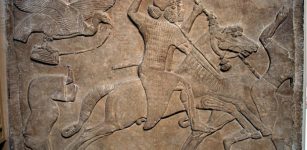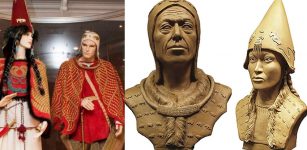Spectacular Victory Tower Dedicated To Hindu God Vishnu And Pioneered By King Rana Kumbha
A.Sutherland - AncientPages.com - Many spectacular architectural masterworks of India, like temples, mosques, monoliths, statues, gigantic forts, palaces, universities, and tombs, are left in legacy by the country’s builders.
One of them is the famous Victory Tower (Vijaya Stambh) at Chittorgarh fort, located in Chittorgarh city, Rajasthan, western India.
Tower of Victory (Jaya Stambh) erected by Rana Kumbha to commemorate his victory over Mahmud Khilji of Malwa in 1440.
The tower is dedicated to the most popular Hindu god, Vishnu, considered the world's god.
However, numerous other drawings and inscriptions of various Hindu gods and goddesses can be seen.
This impressive structure of India's craftsmen was built partly of red sandstone and partly of white marble. It has nine floors, and its remarkable height is 37 meters. The tower is a square structure that stands on a pedestal 10 feet (3.0 m) high. Each of the nine floors has openings and balconied windows on all four sides.
The most extraordinary thing is, the victory tower is visible from any area of Chittorgarh city. For reaching the top floor, there are 157 narrow stairs. The building's interior is full of various carvings, and the towers' murals display Hindu divine gods and goddesses and depictions images from the familiar Ramayana and Mahabharata epics.
After reaching the top of the tower, anyone can see a great and unique view of the whole city.
Without a doubt, the Tower of Victory is considered the finest example of the Rajputana style of art and architecture with highly decorative and beautifully carved elements.
Rana Kumbha pioneered the building of the tower to commemorate his victory over Mahmud Khilji of Malwa, the Muslim ruler of Delhi. This magnificent piece of architecture was built to celebrate the matchless bravery shown by Rajput Kings of that time.
Rana Kumbha (1438-68) was India's great historical figure remembered as the ruler of Mewar, a state in western India between 1433 AD and 1468 AD'. Mewar was considered the world's oldest-serving dynasty.
Rana Kumbha belonged to the clan of Rajput - descendants of ruling Hindu warrior classes of North India - who would rather die in battle than surrender.
When India was under the rule of Muslims, the brave Rajput King Rana Kumbha stood and held the Hindu flag. It was undoubtedly a very emotional attitude because Mewar was the only central state that was independent at that time.
Kumbha was a powerful and very popular ruler who loved art and culture. He was a king who never lost in battle. He represented the Rajput clan, described throughout history as warriors who fought bravely with many successes and could meet death without any fear.
A closer look at some of the many magnificent carvings of the Victory Tower, Rajasthan, India. Credit: Adobe Stock -Sundeep
But we must not forget, he was also among the most active patrons of the buildings. The Rajput rulers being great builders spent lavishly on constructions other than temples. They built dams, artificial lakes, canals, arched gateways, towers, fortresses, and palaces. Many of these buildings even today attest to the Rajput skill in architecture and engineering.
Written by – A. Sutherland - AncientPages.com Senior Staff Writer
Copyright © AncientPages.com All rights reserved. This material may not be published, broadcast, rewritten or redistributed in whole or part without the express written permission of AncientPages.com
Expand for referencesMore From Ancient Pages
-
 First Evidence Common People Drank Wine In Troy (Not Just The Elites)
Archaeology | Mar 31, 2025
First Evidence Common People Drank Wine In Troy (Not Just The Elites)
Archaeology | Mar 31, 2025 -
 World’s Oldest Hand Stencils Were Made By Neanderthals In The Maltravieso Cave 66,000 Years Ago
Archaeology | Dec 9, 2024
World’s Oldest Hand Stencils Were Made By Neanderthals In The Maltravieso Cave 66,000 Years Ago
Archaeology | Dec 9, 2024 -
 Oldest Indo-European Calendar Based On The Orion Constellation Is Engraved On A Vucedol Vessel
Artifacts | Jun 7, 2021
Oldest Indo-European Calendar Based On The Orion Constellation Is Engraved On A Vucedol Vessel
Artifacts | Jun 7, 2021 -
 4,000-Year-Old Serpent-Shaped Wooden Stick Unearthed in Southern Finland
Archaeology | Jun 30, 2021
4,000-Year-Old Serpent-Shaped Wooden Stick Unearthed in Southern Finland
Archaeology | Jun 30, 2021 -
 Chickens Were Introduced To Britain, Mainland Europe, And Northern Africa Later Than Previously Thought
Archaeology | Jun 13, 2022
Chickens Were Introduced To Britain, Mainland Europe, And Northern Africa Later Than Previously Thought
Archaeology | Jun 13, 2022 -
 Golden Stool Of Ashanti People And Legend Of The Black Cloud Appearing In The Sky
Artifacts | Sep 27, 2020
Golden Stool Of Ashanti People And Legend Of The Black Cloud Appearing In The Sky
Artifacts | Sep 27, 2020 -
 Mystery Of The Marble Lions On The Sacred Island Of Delos Solved?
Archaeology | Oct 12, 2021
Mystery Of The Marble Lions On The Sacred Island Of Delos Solved?
Archaeology | Oct 12, 2021 -
 Drone Footage Reveals Ancient Mesopotamian City Lagash Was Made Of Marsh Islands
Archaeology | Oct 14, 2022
Drone Footage Reveals Ancient Mesopotamian City Lagash Was Made Of Marsh Islands
Archaeology | Oct 14, 2022 -
 Ancient DNA Sheds New Light On The Fall Of Major Civilizations
Archaeology | Aug 9, 2022
Ancient DNA Sheds New Light On The Fall Of Major Civilizations
Archaeology | Aug 9, 2022 -
 Evidence Scots And Irish Settled Iceland A Century Before The Vikings?
Featured Stories | Jan 7, 2023
Evidence Scots And Irish Settled Iceland A Century Before The Vikings?
Featured Stories | Jan 7, 2023 -
 Invention Of Ancient Military Technologies Throughout World History Investigated
Archaeology | Oct 23, 2021
Invention Of Ancient Military Technologies Throughout World History Investigated
Archaeology | Oct 23, 2021 -
 European Neolithic Family Trees Shed Light On Social Organization
Archaeology | Jul 27, 2023
European Neolithic Family Trees Shed Light On Social Organization
Archaeology | Jul 27, 2023 -
 12,000-Year-Old Crater Dipsiz (‘Bottomless’) Lake, Searched For Gold, And Destroyed In Legal But Controversial Excavation
Archaeology | Nov 17, 2019
12,000-Year-Old Crater Dipsiz (‘Bottomless’) Lake, Searched For Gold, And Destroyed In Legal But Controversial Excavation
Archaeology | Nov 17, 2019 -
 Stunning Facial Reconstruction Of ‘Siberian Tutankhamun’ And His ‘Queen’ Who Died 2,600 Years Ago
Archaeology | Jan 12, 2021
Stunning Facial Reconstruction Of ‘Siberian Tutankhamun’ And His ‘Queen’ Who Died 2,600 Years Ago
Archaeology | Jan 12, 2021 -
 What Was Pax Deorum And How Important Was It?
Ancient History Facts | Apr 30, 2023
What Was Pax Deorum And How Important Was It?
Ancient History Facts | Apr 30, 2023 -
 Impact Of European Contact With Pacific Islands Was Devastating – New Study Reveals
Archaeology | Sep 30, 2022
Impact Of European Contact With Pacific Islands Was Devastating – New Study Reveals
Archaeology | Sep 30, 2022 -
 What Can Fossil Footprint Discoveries Tell Us About The Past?
Featured Stories | Aug 16, 2023
What Can Fossil Footprint Discoveries Tell Us About The Past?
Featured Stories | Aug 16, 2023 -
 Mysterious Water Source Belonging To The Goddess Of The Cold Kingdom Of Evil Remains An Archaeological Puzzle
Ancient Mysteries | Dec 6, 2019
Mysterious Water Source Belonging To The Goddess Of The Cold Kingdom Of Evil Remains An Archaeological Puzzle
Ancient Mysteries | Dec 6, 2019 -
 Escape Tunnel From Crusader Citadel In Tiberias To Sea Of Galilee – Discovered
Archaeology | Jun 15, 2017
Escape Tunnel From Crusader Citadel In Tiberias To Sea Of Galilee – Discovered
Archaeology | Jun 15, 2017 -
 Unique Ornamented Golden Bronze Age Belt Discovered Near Opava, Czech Republic
Artifacts | Oct 28, 2022
Unique Ornamented Golden Bronze Age Belt Discovered Near Opava, Czech Republic
Artifacts | Oct 28, 2022



